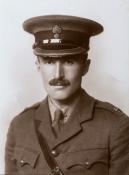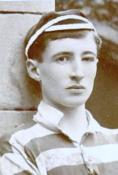
|
The King's School Canterbury |
Roll of Honour |
| 2nd Lieutenant Charles John Norman ADAMS | |
|
No.2 Company 2nd Battalion Grenadier Guards Date of birth: 7th January 1889 Date of death: 14th November 1918 Died of wounds aged 29 Buried at St Sever Cemetery Extension S Plot V Row I Grave 7 |

|
| He was born at Rosario de Santa Fe in the Argentine Republic on the 7th of January 1889 the younger son of the Reverend George Alophus Samuel Adams, Rector of Nettlestead, and Beatrice (nee Norman) of Nettlestead Rectory near Maidstone in Kent. He was educated at the Junior King's School from September 1897 and at the King's School Canterbury to July 1908 winning a Junior Scholarship in July 1904 and a Senior Scholarship in July 1905. He was made a monitor in September 1906 and Captain of School from September 1907. He played scrum half for the school Rugby XV for three years gaining his colours in 1907/8 and 1st XI Cricket from 1906 to 1908. Of his 1907/08 rugby season, the Cantuarian wrote:- "Performed the less showy task of scrum half very well. Very slow in the early part of the season, he became much smarter and worked on a good understanding with Gardener. Useful dribbler and saves pluckily." During the 1908 cricket season he averaged 29.7 with the bat and in its end of season report the Cantuarian recorded:- "Immensely improved bat with much increased power and variety of strokes. Good field as a rule." He also earned his sports colours in 1908 and was in the Fives Pair in 1907 and 1908. He was Secretary of The Cantuarian from May 1906 and became Editor in September the same year. He was President of the Debating Society from September 1907 and was a member of the Sports Committee from September 1906. He achieved his Higher Certificate in 1907 with a distinction in Divinity, and was elected as a Stanhope Exhibitioner in July the same year. In 1908 he obtained an Open Classical Exhibition to St John's College Oxford where he achieved 2nd Class Classical Mods in 1910, the Casberd Scholarship in 1912, 2nd Class Lit Hum in 1912 and a BA, 2nd Class in Modern History in 1913. He played for his college at both cricket and rugby becoming captain of both teams. He was President of the College Debating Society. On the 28th of October 1908 he joined the Oxford University Officer Training Corps where he served in D Company and rose to the rank of Colour Sergeant before being commissioned as a 2nd Lieutenant on the Unattached List for the Territorial Army on the 17th of December 1912. He achieved Certificate A in May 1910 and served with the Corps until the 8th of September 1913. On leaving university he became an Assistant Master at Glenalmond College and served in the Officer Training Corps there from the 9th of September to the 19th of December 1913 when he left the school. From the 20th of December 1913 he worked as an Assistant Master at Marlborough College where he was promoted to Lieutenant in the Officer Training Corps on the 29th of May 1916. From the 26th of December 1914 to the 8th of January 1915 he was attached to the 8th Battalion Duke of Cornwall's Light Infantry and from the 19th of April to the 28th of April 1915 he attended a course of instruction at the School of Musketry at Hayling Island. From the 17th of April to the 6th of May 1916 he attended a course at the School of Instruction at Chelsea Barracks. He attended a gas course in July 1916 and later attended the Lewis Gun School of Instruction. He was appointed as House Master of "A" (Junior) House from January 1915 to Easter 1918. He applied for a commission in the army on the 14th of April 1918 in which he expressed a preference for the Royal Artillery or the infantry and for the Grenadier Guards in particular. He resigned his position with the Officer Training Corps on the 19th of April 1918. He was commissioned as a probationary 2nd Lieutenant in the Grenadier Guards on the 20th of April 1918 and was confirmed in that rank on the 18th of June 1918. He joined the 5th (Reserve) Battalion Grenadier Guards at Chelsea Barracks on the 14th of September 1918 and landed in France on the 22nd of September 1918 where he joined the 2nd Battalion of his regiment in the field and was attached to No. 2 Company. On the 4th of November 1918 the 2nd Battalion of the Grenadier Guards was ordered to advance in support of the 2nd Battalion Coldstream Guards for an attack on the line of the Fresnay- Wargnies- Le Petit road then to pass through them and secure a second objective some 2,000 yards beyond. No 2 Company was in support of Nos. 3 and 4 Companies who were in the vanguard of the Grenadier's advance. The attack began at 7.30am. Earlier rain had stopped, but a very heavy mist hung over the ground cutting visibility to no more than 200 yards. As the leading companies passed over the high ground south west of Wargnies Le Petit the mist suddenly lifted and they came under "devastating" machine gun fire from the north and they suffered heavy casualties. They took their objectives and consolidated their position during the afternoon with the 1st Battalion Irish Guards passing through their positions at 6.30pm to continue the advance. Charles Adams was wounded while leading his platoon in this attack and was evacuated to No 8 General Hospital in Rouen where he arrived on the 8th. He had been wounded in the lower spine and his lower limbs were paralysed, had he survived he would have been confined to a wheelchair. He was given a transfusion as part of his treatment and his family were summoned on the 13th but he died of his wounds on the 14th of November. His father received the following telegram dated the 15th of November 1918: - "Deeply regret 2/Lt C.J.N. Adams 2 Grenadier Guards died of wounds November fourteenth. The Army Council express sympathy." The Marlburian wrote of his time as a master at Marlborough College: - "If he played cricket he nibbled or whacked at every off ball that came along. If he bandied words in argument he was quick and restless and sometimes trod on peoples toes, but he did it as one without guile or malice and the hurt never lasted very long. He was by nature absolutely generous and genuine. This does not mean that he allowed his heart to rule his head; for he had a clearness of vision that to poor erring mortals made him seem perhaps a little hard at times. And if he was a "bit of a dragon in form" it was only because he was too thorough himself to be easily satisfied with others. In actual fact his heart was very large and very humble. "What a waste!" one wrote on learning of his death." He is commemorated on the Common Room Memorial outside the chapel at Marlborough College and on the memorial at St John's College Oxford. |
|
 | |
Back